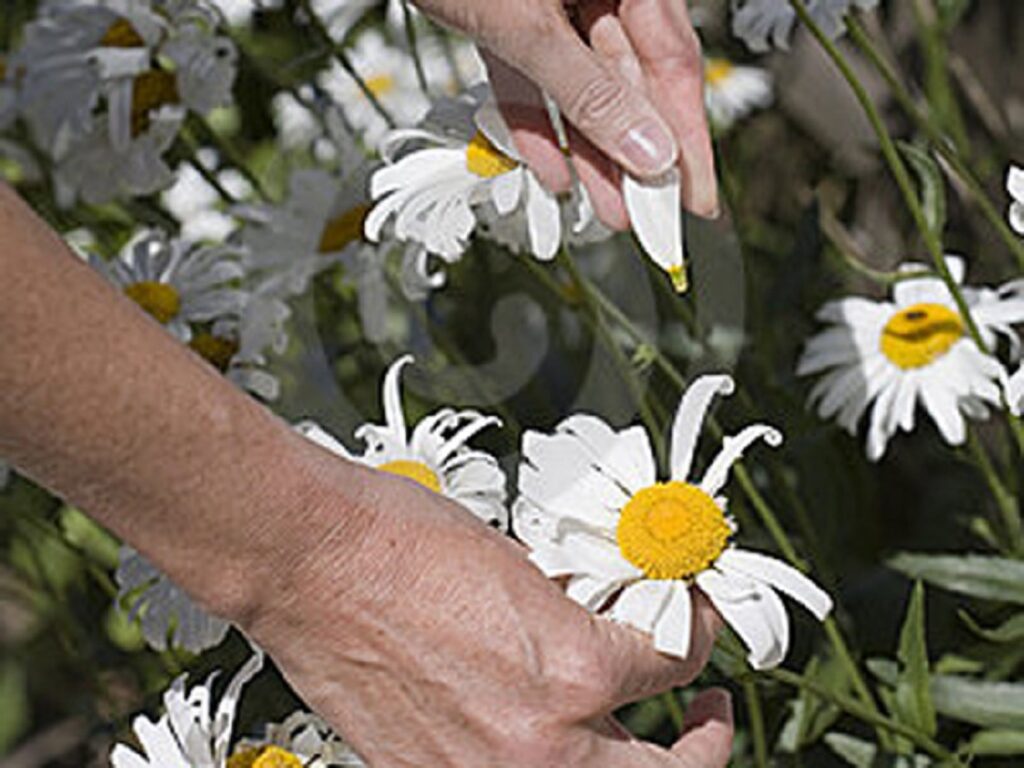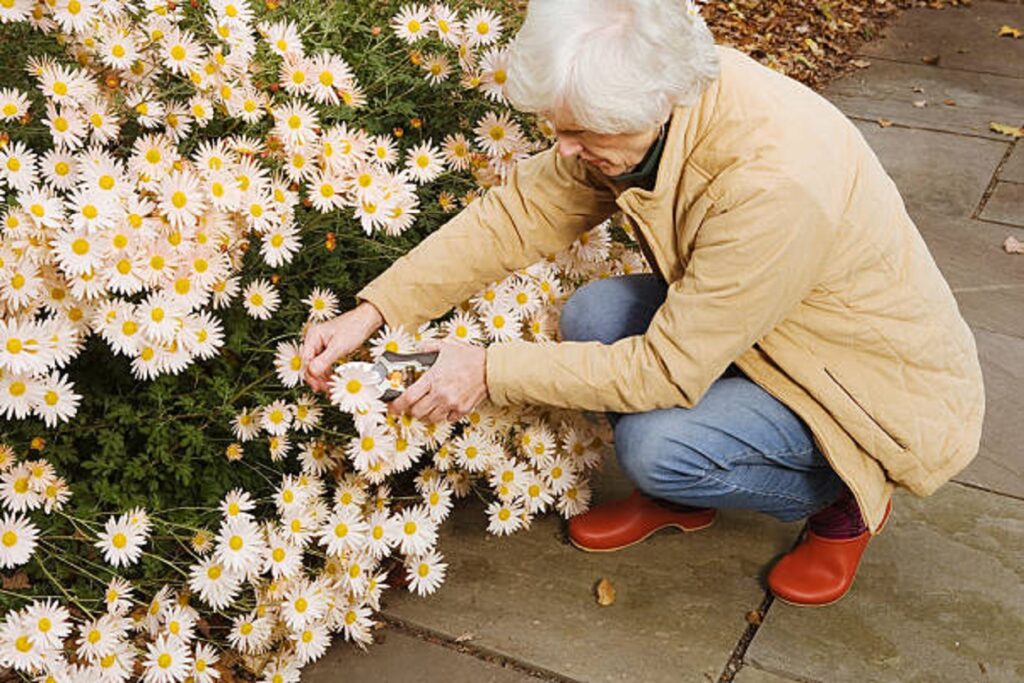Daisies are very striking because of their white petals and yellow center, they are popular flowers, because of the tradition of removing their petals when you want to know if they love you. Daisies are herbaceous, perennial plants that their growers prune to increase the number of flowers, and maintain the vitality of the plants. Next we will tell you how to prune daisies and when?

How to Prune Daisies
the daisy (Chrysanthemum leaucanthemum), It is a herbaceous plant between 15 and 0,80 meters high, native to Europe, each flower is supported by a long and thin stem, its leaves are lanceolate with jagged edges, dark green. The flowers are medium-sized and white and sometimes yellow. They reproduce by seeds. Because of their beautiful flowers, Daisies are used to decorate houses and gardens, where they are planted in pots or directly on the ground. To increase their flowering and maintain their health, it is good to prune these plants.
Reasons to Prune
The objective of Pruning Daisies is to improve the health of the plant and maintain its vitality for longer. The intention is to remove those damaged parts of the plants, such as leaves and flowers to prevent the proliferation of diseases and pests. In this way the plant directs its energy to strengthen healthy parts and improve their development and appearance. Pruning Daisies helps you:
- Cause plant growth
- Improve the health of the plant, by removing diseased or dead leaves and flowers, avoiding infection by fungi and bacteria
- Allows better light and air to reach healthy daisy plants
Time to Prune Daisies
The appropriate time to prune daisies is preferably at the beginning of the spring season and at the end of the winter season. Pruning is done once the frosts have passed and the plant is still in a vegetative state, so that less salvia is lost, and the plant heals quickly and recovers quickly. Daisy pruning in the fall season can be done in places with warmer temperatures and less cold winters.
To maintain the daisy plants, it is suggested to carry out maintenance pruning, this can be carried out at any time, as it consists of eliminating the suckers or small branches that appear between the main stem and its branches. It is recommended that they be pruned when their size is less than 5 centimeters.
How to Prune
It is suggested to have small gardening or pruning shears, gloves, and protective glasses on hand. Before starting, disinfect the scissors with alcohol, passing them with a cotton ball or leaving them for about 10 minutes in a container with a little alcohol, the latter is preferable when there are many flowers to be pruned. Pruning varies depending on the desired result:
Thinning or cleaning of the plant. This pruning is done to eliminate dry or weak branches and obtain free spaces, so that new branches of the plant come out. This pruning is suggested to be carried out at different times of the year. You start by removing the suckers:
- It begins by locating the emergence of suckers or secondary shoots, these grow between the main stem and the first leaves.
- Once located, once disinfected with pruning shears, the suckers are carefully cut, the cut is made as close as possible to the stem, without causing damage to it. This Pruning is done when the sucker measures about 5 centimeters.
- The cut is made diagonally to help the plant heal faster and prevent the accumulation of water or the entry of water through the wound and cause tissue rot and subsequent disease.
- It is used later, also to remove, sprouts of the plant that grows at the foot of it, the stems and sick or withered leaves, and also the withered flowers.
- During the year the leaves and stems can die for various reasons, for this reason it is suggested to remove the dead parts, when you detect them, they are distinguished by their brown or dark brown or black color, and by their fragility. They are removed manually or by cutting with pruning shears.
flowering pruning. To increase the quantity and quality of the daisy flowers, flowering pruning is carried out. This is done once a year, at the end of the winter season or beginning of the spring season, it is carried out as follows:
- You start by removing the dead flowers before they start to produce seeds, so that the plant directs its energy to the production of new flowers, instead of producing seeds in the dead flower bud. Dead flower stalks are easily pulled out of the ground.
- The pruning will be carried out on those branches or stems at a height of 10 centimeters, this will allow the stems to continue growing and the flowers to sprout, at similar heights in all the branches.
- The branch that flowered is cut, the pruning is done by counting two nodes above the ground, the branch that only flowered is pruned. This will stimulate the plant to grow new shoots that will flower the following year.
- Crisscrossing and stunted branches are cut above two nodes above the ground.
- Avoid Pruning the branches that have not flowered, because these will be the ones that will flower in the next season. In case any stem is very long or short, in proportion to the rest of the plant, it is suggested to cut it to balance the shape of the Margarita plant.
- New stems growing directly from the ground will not flower this season, because it is ripening for the following year. Just like those young stems you stopped pruning.
- For the daisy plant to bloom with good flowers and in abundance, an environment with a lot of light and enough moisture in the soil is good.
After performing the flowering pruning, you have to wait between 2 to 3 weeks for the outbreak of new flowers. Daisy plants flower fast and respond well to pruning, once you prune them you will start to see new flower growth in the next 14 to 20 days or so. On the other hand, if you let the pruning pass, you will observe the stems with flower buds forming seeds and others with seed pods.
Prune to renew the plant. This renewal pruning is done to help the plant develop new, healthy shoots. The pruning of Margaritas consists of pruning or cutting the parts of the Margarita plant that are sick, withered, damaged and cleaning them to avoid the proliferation of phytopathogens. In addition, new and healthy shoots are born. It is good to prune before the plant flowers. This Pruning of Margaritas is done to rejuvenate or enliven the plant, it can be carried out progressively or severely:
- Severe pruning for rejuvenation. If you notice that the plant is in good condition and can withstand this pruning, proceed to cut or prune the entire plant near the base of the plant, that is, at ground level.
- When you notice that most of the daisy flowers have withered and start to produce seeds, prune the plant.
- Progressive pruning for rejuvenation. It consists of cutting half of the branches, these branches will be pruned near the base and the remaining branches will be pruned to half their size or the best bud that the plant has will be trimmed.
Varieties of Daisies
About 20.000 is the number of different species and cultivated varieties of Daisies that have been recognized. Competing with orchid plants, in terms of the number of varieties and species that are known so far. Of all these numbers of Daisies, some are more common in gardens and as cut flowers. Below are some of the best known.
Daisies (Echinacea purpurea)
This species is native to North America, it reaches about 120 centimeters in height. The color of its petals is deep purple. In the central button there are small flowers that make it very striking.
the giant daisy
These are the well-known daisy flowers with white petals and a contrasting yellow center, large in size. It is grown in places with good sunlight, well-drained soil, which allows moisture to be maintained without flooding the soil.
Margaret Gerber
It is distributed in the Asian continent, South Africa and Madagascar. Due to the beauty of its flowers and the fragility of its stems, it is used to make bridal bouquets and flower arrangements. The color of its petals is darker in the center, and brighter colors at their ends.
marl ( Argyranthemum frutescens)
This species comes from the Canary Islands and is characterized by having petals with colors that vary from pure white, pink and yellow. It requires well-fertilized soil with good drainage, direct sunlight and frequent watering. They use it as a medicinal plant.
rudbeckia
The petals of its flowers are dark red in the center and yellow at the ends, resulting in very beautiful flowers. They are plants that measure between 0,5 to 3 meters. For being plants resistant to well-drained soils and sunny places. It is cultivated as ornamental plants in gardens and orchards.
So that you continue enjoying the wonderful nature, I invite you to read:


